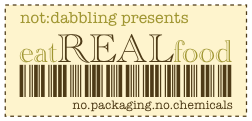It was pretty successful, actually.
Of course, I like to clean (don’t tell my kids), and I get positively giddy over big reorganization projects. Some of the fussiness of the way Apartment Therapy goes about it (flowers! Frame That Art! Was there something about cute hand creams? I d’no) set my teeth on edge, but I get it. All clean and no play makes for a let’s-not-finish-the-January-Cure.
So here’s a day by day:
1. The First Step: Create a Project List
Yup. Did it. However, I must confess that I have on-going lists. I have a whole moleskin devoted to lists. One of the things I put on the list was painting chalkboards at strategic spots around the house so I could make lists.
2. Weekend Chores: Flowers & Floors
Well, you know my feeling about flowers. Expensive, chore-like, and unsustainable. Floors are the one big task of the cure that I really regret missing. That was the weekend of the 12″ snow, so I shoveled. Does cleaning the sidewalk count?
3. 10 Mindful Minutes: Get a Fresh Perspective
Loved this. Not sure how it affected the cleaning project, but I loved having an actual excuse to sit and stare out the window. “Hey, the Cure said…”
4. A Simple Step to Success: Set Up an Outbox January Cure:
I don’t need an outbox. I need a time machine. My problem is not that I don’t get rid of things I don’t need. It’s that I get rid of things I shouldn’t. I spend a lot of time going through trash cans (yes, and dumpsters) for the stuff that I should not have thrown out.
5. You Can Do It: Pick a Project to Cross Off Your List
I managed to do one of them– cleaning the basement, including my list-ready chalkboards. Did not get to the other one, figuring out a solution for my several dozen necklaces.
6. Making Your Home Your Own: Prep Artwork for Framing & Display
I rolled my eyes at this one, but in fact I actually did do this, because when I was cleaning the basement I found a beautiful drawing by my old art buddy Karen Lyverse. It is now hanging in my foyer. Thanks, January Cure.
7. Weekend Chores: Flowers, Kitchen Organizing & Cleaning, Make a Meal
Sweetie, flowers again? Also, I make all my meals already. Do people who live in apartments not make meals? But yes, kitchen organizing. I love kitchen organizing. Now, there wasn’t that much organizing to do this year, since my ex organized me out of most of my stuff already, but I did get a 20-year goal completed and managed to caulk behind the sink. Don’t ask.
8. Keep Yourself on Track: Get a Get-Together Together
That’s for today. But it’s not for the January Cure, it’s gathering a couple of girlfriends for a major rant on my evil ex.
9. The Clutter Filter: Create a Landing Strip
Sigh. Seriously, do grownups need a special place to put stuff until they put it away? Just for god’s sake put stuff away.
10. Unplug for an Evening: Try a Media Fast
hahahahahahahah
11. The Halfway Point!: Project Progress
Oh, was I supposed to track this halfway through?
12. Weekend Chores: Flowers, Bedroom Cleaning & Wardrobe Organizing
Yeah, that was the necklaces (the rest of the bedroom got reorganized in the break up)
13. Less Mess & Stress: Getting Your Paperwork & Files Organized
From this I infer that people don’t routinely keep their paperwork and files organized.
14. Worth It: Clear Up Cord Clutter
I don’t have electronics, for the most part.
15. Declutter & Organize: Bathroom Cabinets Cleanout
I was into this, until I discovered that my medicine cabinet has almost nothing in it. Can’t decide if this is empowering or depressing.
16. Lightening Up: Declutter Media Collections
Also not a media consumer. I would love to get rid of Wei’s records, still in my basement, but that would probably not be in the spirit of “amicable divorce.”
17. Weekend Chores: Flowers, Outbox, Living Room & Lighting
Sigh
18. The Assignment We’ve All Been Waiting For
No clue.
19. A Gift to Yourself: Hang that Artwork!
And it looks just great. Thanks for the push, JC.
20. Final Stretch: The 60 Minute Quick Clean
I have no idea what this was. Are you seeing a theme here? Towards the “end days” it begins to get difficult to keep going.
21. The Last Lap; 22. Weekend Chores
I think the Apartment Cure people were getting tired too.
I will definitely do it again next year.
Did you do the January Cure? Do you like it better than traditional spring cleaning?

















